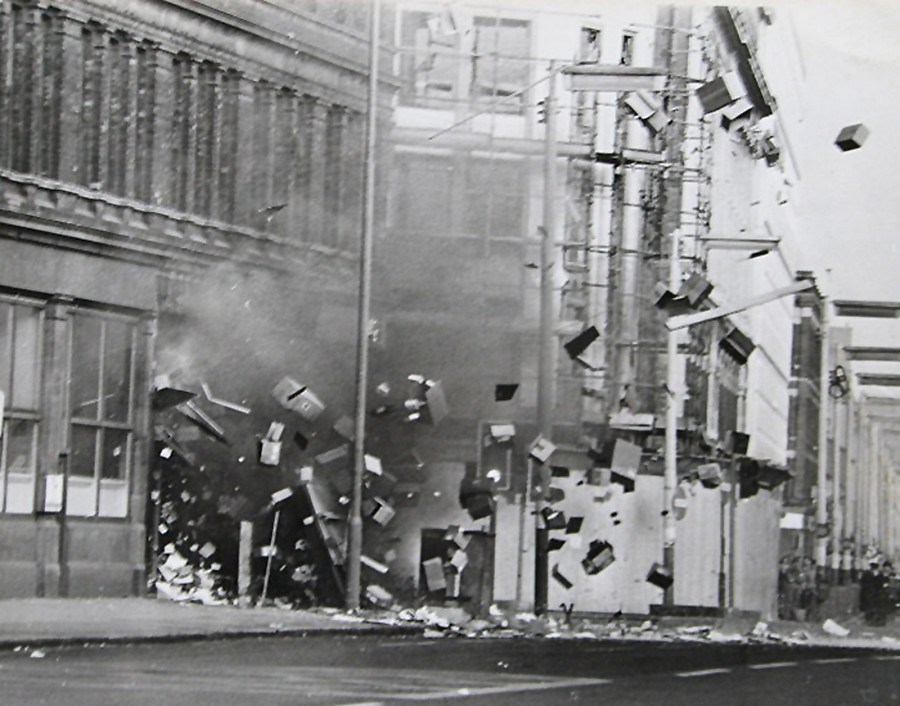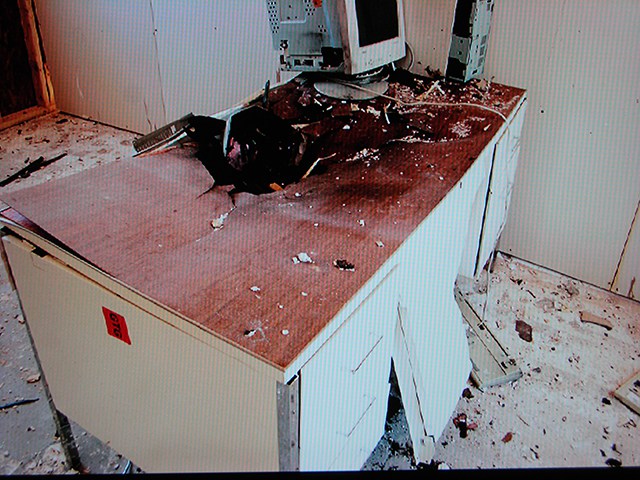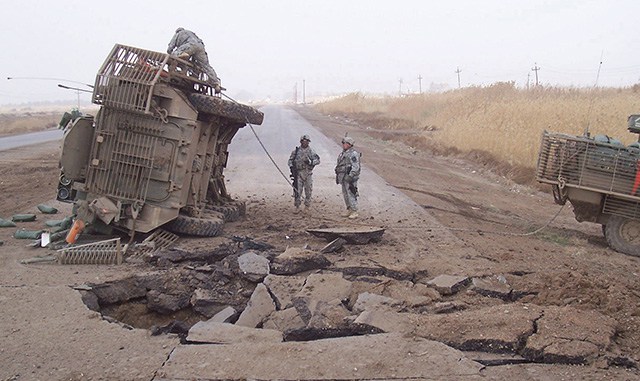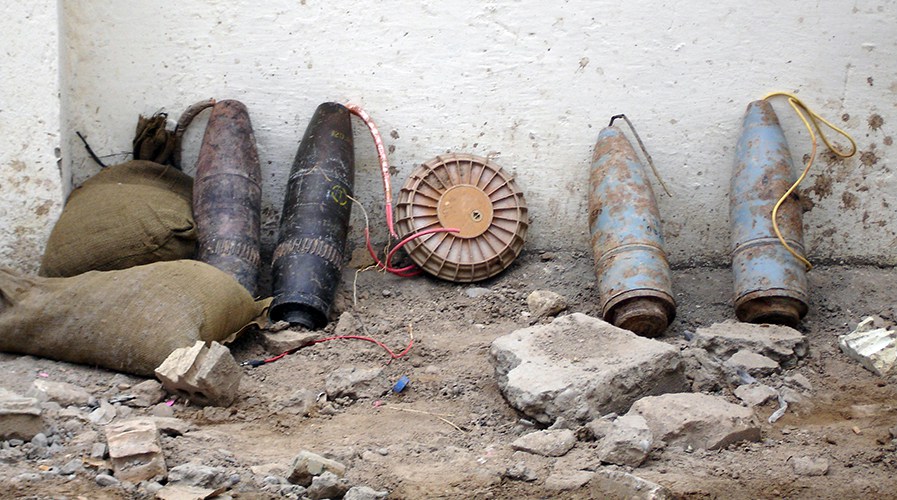
If you are working in the center of a large city, like London or New York, or are working in the emerging markets, where bomb scares are not unusual, it is possible that you may get caught up in an Improvised Explosive Device incident. Whether your venue, office or residence is targeted directly or it just happens to be on the same street as an IED, you will need to know how to react. Improvised Explosive Devices (IEDs) are a threat to everyone and are used frequently and with great affect by criminals, cranks and terrorists the world over. If you follow international events, then you will see that there is a lethal bombing somewhere in the world almost every day.
The basic IED can be made from commercially available materials that are sold over the counter in most places. Information on how to construct IEDs is available from military or survival bookstores, the Internet and former military personnel. The size of an IED can range from as small as a cigarette packet to as large as a large container lorry. IEDs can be disguised as virtually anything; this gives the bomber the advantage of being able to kill their targets without alerting them to the threat, giving the bomber a large degree of anonymity. IEDs can be used to kill selected targets or to kill indiscriminately. These facts are why the IED is often the favored weapon of criminal, cranks and terrorists the world over and is the most dangerous threat to security, law enforcement, military and the general public.
Here I have listed some basic information and some basic guidelines for dealing with an IED incident and in part 3 I will dissect a law enforcement response you a recent incident in NYC, after reading this you should be a lot more competent than those members of the NYPD who were running that circus!
Bomb and Improvised Explosive Device Identification
Bombs and IED’s can be disguised as virtually anything. You need to be suspicions of any objects, cars or activity in or around your locations. An unattended bag, an unknown car that has been parked next to your building to long, unknown people acting nervously… You and your employees must be aware and suspicious; everyone also needs to be trained on how to deal with a suspicious object or in the worst case scenario the aftermath of a bomb/IED incident!
The Secondary Device
A bomb explodes in a stationary shop in Royal Avenue,Belfast
The IED can be used on its own or in conjunction with other IEDs or weapons. Good bombers will always place a second device near the first device, in a likely control point for security forces or on an evacuation route from the area of the first device. The second device is to catch the personnel or emergency services coming to the aid of anyone hurt in the first blast, or security forces dealing with the incident or personnel escaping from the first blast. Sometimes the first device is designed to go off for no other reason than to draw in emergency or security services or drive people into the larger main device. You must always consider if an explosive device has been found, gone off or that there could be a second or third device somewhere.
Here are some basic examples of how IEDs would be employed by Irish terrorists; these are taken from when I was a teenager serving in the British Army in Northern Ireland in the late 1980’s to early 1990’s.
- A man is murdered in the shoe shop that he runs, he was shot at close quarters. The murders left behind an explosive device in a shoe box set to detonate 30 minutes after the shooting, by which time security forces and emergency services were in the immediate area. Think about how many shoe boxes there are in a shoe shop! The device detonated but no-one else was hurt due to the fact that secondary devices were expected to be left at crime scenes.
- A car bomb is detonated in a small village and wounds several people. The security forces and emergency services are limited to number of routes that they can use to get to the village. It would be expected for an IED to be placed along one of the routes into the village to catch the security forces entering or leaving the area. If time was available the routes would need to be searched and cleared, if time and helicopters were not available this would consist of the responding patrol in driving in at top speed.
- A car is parked a short distance from a security force base with what appears to be mortar tubes inside. A security force cordon is placed around the car to secure the area and. When the security force teams are conducting their clearance searches around their cordon points, a team finds an IED attached to a trip wire. Further searches of the cordon positions turn up other IED’s. The mortar tube in the car turned out to be a piece of drain pipe, it was a hoax that was used to draw security forces into the IED’s that the terrorists placed in likely security force cordon positions.
- A car is parked on the side of a country lane in an area regularly patrolled by security forces. When a security force patrol spots the car, they check with their control room to see if the car is registered as stolen. It’s not. The patrols have been on the ground for four days and are rushing to make it to their pick up point on time. The patrol can see nothing suspicious with the car, so they send two members of the patrol forward to check out the car. One of the team who goes forward to check the car is carrying electronic counter-measure equipment that can identify and block radio signal for remote-controlled bombs. The bomb was not remote-controlled or in the car. It was in a ditch a few meters from the car and detonated with a command wire.
You should take nothing at face value and always remember the secondary device. Always be suspicious of anything that looks out-of-place, if you are in an area where there is an active IED threat you need to draw up pans and procedure of how you will respond if you are caught up in an incident.
Types of device
Letter & parcel bomb
Damage from a letter bomb.
The letter and parcel bomb is the most widely used of all IEDs. The bombers who use this type of device range from stalkers through to hard-core terrorists. The letter bomb gives the bomber a direct line of access to the target and affords the bomber virtual anonymity for themselves, as the device can be sent from anywhere in the world. As the name suggests, the device is placed into an envelope or parcel and posted to the target. Upon opening the device explodes.
Defense against letter and parcel bombs
Below is a list of things that should be checked for on any package that you suspect as being an IED. If you or your client is under a threat, all mail should be checked. If some of the following criteria are evident on a suspect package, it should be put through an x-ray machine to confirm or ally your suspicions. If you don’t have an x-ray machine, then the suspect package should be placed in a safe area and specialist assistance sought. The package would have been knocked around whilst in the postal system, so it will be safe to move-just don’t open it.
Letter and parcel bomb recognition check list:
- Were you expecting the letter or package?
- Was it delivered by hand (to avoid the postal system)?
- Is it uneven or lopsided?
- Is the envelope rigid?
- Is there excessive securing material such as cello-tape, string, etc.?
- Are there any visual distractions on the envelope such as company, official stamps?
- Are there any protruding wires or tin foil?
- Was there excessive postage paid?
- Was the address poorly written/typed?
- Any excessive weight?
- No return address?
- Any oil stains, discoloration, fingerprints?
- Any incorrect titles?
- Any titles but no names?
- Any misspellings of common words?
- Any restrictive markings such as Confidential or Private?
- Any suspicious postmarks such as Belfast or Baghdad, etc.?
- Is the address stenciled?
- Any holes or pinpricks, which could be to let out explosive fumes?
- Any smell of almonds, marzipan or perfume used to mask the smell of explosive fumes?
- Any mechanical sounds?
Incendiary devices
A simple form of this device can be made as small as a cigarette packet and be made from condoms and commercially available chemicals. When properly ignited, they will burn at high temperatures and are primarily designed to destroy property. Incendiaries require an initiator (flame or chemical action), delay mechanism, igniter and main incendiary charge. Incendiary bombs are usually used against shops and businesses. They can easily be placed between the cushions of furniture or among flammable objects, in the case of thermite, on or above machinery or vehicles, and timed to go off when the business is empty of staff, causing the maximum fire damage. This can also help to give the bomber anonymity.
Defense against incendiary devices If either your client or his business is under the threat of incendiary attack, the following precautions should be taken. A deterrent would be to install overt CCTV and employ high-profile 24-hour security guards. The CCTV could, in the event of an incident, be used to identify the bomber. Keep videos in a fireproof container. If the client’s workplace is an office suite, then access needs to be restricted as much as possible. Visitors should not be left unsupervised. Cameras should be placed in high-risk areas entrances/exits and outside toilets. All personnel entering the suite should be searched.
Blast bombs
This device can be made very small. A device can easily be placed in a take away food container or bag and placed in a bin or pile of rubbish. In the UK, Irish terrorists have been known to put and detonate IEDs inside of bicycle frames. This type of device is used to cause disruption and confusion. In the city of London, UK, in the early 90s, a spate of such devices placed in rubbish bins resulted in all bins being removed from the streets and the London Underground. These devices can cause great disruption and kill indiscriminately.
Defense against blast bombs Realistically, there is very little that can be done to stop a bomber planting these devices in city areas. The device can be easily disguised and moved during rush hour. It would be impossible to watch everyone, let alone search them. Security cameras on buildings and in shops would be useful when trying to identify the bomber after the device has detonated. If your client is attending a function where there is a threat from IEDs, precautions need to be taken. The empty venue should be searched by experienced personnel with, if possible, sniffer dogs. After the search, strict access control needs to be put in place with every entrance/exit covered and everyone entering the venue searched. Special attention should be paid to casual staff hired just for that function.
Photo by courtesy of C-52 of 3/2 Stryker Brigade Combat Team
see: http://www.army.mil/-news/2008/06/06/9708-general-lee-rides-again/
Undercar Booby-trap (UVB)
This device is a favorite weapon of Irish terrorist’s groups. The device is placed in a container such as an empty video case or a Tupperware container and attached to the vehicle using magnets. The usual method for triggering the device is by using a tilt or vibration sensitive switch. The UVB enables the terrorists to attack selective targets. There is a risk of discovery involved when placing this device as access to the targets vehicle is needed. If the bomber manages to plant the device, it will kill and maim the occupants of the car if it is not discovered.
Defense against UVB The best defense against the UVB is to deny the bomber access to the vehicle. If the vehicle is secured in a garage, the entrance and driveway to the garage need to be physically checked before the vehicle is moved. There could be a device attached to the door of the garage or a mine in the driveway. If the vehicle has to be left unattended, then on return the vehicle and the surrounding area needs to be searched. Searching a vehicle for IEDs is an important skill and needs to be practiced regularly.
Car and lorry bombs
Car and lorry bombs enable the terrorist to conceal and move large devices. The car bomb can be used against individual or indiscriminate area targets. The use of the car bomb is very common and over the past few years, this type of device has been used in London, New York and Paris. All it takes is for someone to drive the vehicle to the target and leave it to explode. Against an individual this device could be placed along a route or near an entrance to a building that is frequented by the target. The device can be triggered by remote control, command wire or, if the target is setting a pattern, by a timer. A method of delivering a device to a high security area is to use a suicide bomber or force someone to drive the vehicle with the device in it. The latter is a common tactic of Irish terrorists. It starts with the intended driver being kidnapped or having his home taken over. The driver is then informed that if they don’t drive to the device or to the target they and their family will be killed. If they drive the device, at least he has a chance of survival. The driver is then chained and locked into the vehicle with the device and he is told how long they have got to get to the target before the device explodes. The driver has little choice but to drive the device to the target and hope the security personnel has some bolt cutter on hand with which to cut him out of the car, before the device explodes.
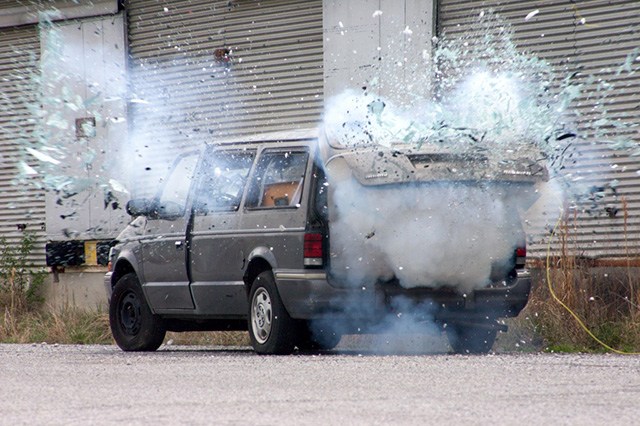
The car bomb can be used against individual or indiscriminate area targets.
Improvised mines
These devices can vary in size and be disguised as virtually as anything. Their triggering methods are only limited to the imagination and ability of the bomber. In Northern Ireland, large devices are usually placed in rural areas in culvert, under roads, or perhaps disguised as milk churns or in bales of hay. In urban areas, they can be placed in lampposts, rubbish bins or in vertical drain piping on the side of a building. To place a bomb into a drainpipe, the terrorist lowers the device into the drainpipe from the top and a command wire detonates the device. The command wire can go over the building or be laid in the guttering connected to a firing point out of the line of sight of the killing zone. In all such operations in Northern Ireland, the terrorists use youths as watchers. The child playing at the end of the street shouting to his friends could be telling the bomber you are in the kill zone.
Sleeper bombs
An IED can be placed in a position a month before it explodes. If it is known that at a certain time in the future you or your client will be attending an event, a function or staying in a hotel at a certain time, precautions need to be taken. In 1984 in Brighton, England, such a device killed five people in an IRA attempt to kill the then British Prime Minister, Margaret Thatcher.
Defense against car bombs & mines
To beat the area car bomber, one has to vigilant and suspicious. If a vehicle looks suspicious, then get it checked out. Security forces have an advantage over private security personnel in being able to check out the background (whether it is stolen or rented) of a vehicle very quickly. So, if you are suspicious of a vehicle, call the authorities and let them check it out; if you are unwilling or unable to contact the authorities, then just avoid the vehicle. For private security personnel: when the car bomb or mine threat is directed at your client, then precautions need to be taken. If there are limited routes in and out of the client’s residence or office, then these routes need to be regularly physically checked. Any suspicious cars, recent digging or wires leading away from the road need to be checked out. When the client is traveling to and from work, the routes must be varied as much as possible. All trips should be kept secret until the last-minute and then be preceded by an advanced security team, which needs to arrive at the client destination with enough time to check out the area before the client arrives. When entering or exiting a building, different entrances/exits need to be used. If possible, use fire escapes and staff entrances. If the client is to stay in a hotel their room will need to be searched along with the adjoining rooms, if possible, and a check kept on anyone using the rooms. If the rooms are booked a while in advance, a check will need to be done on all building work and maintenance carried out in between the time of booking and the time of stay, as this work may have been used to cover the planting of a device.
HOW TO DEAL WITH AN IED INCIDENT
POLICE OR SECURITY FORCES SHOULD BE INFORMED AS SOON AS AN IED IS FOUND OR IF YOU HAVE GOOD REASON FOR EXPECTING AN OBJECT OR VEHICLE OF BEING AN IED. DISPOSAL AND DIFFUSION OF IEDS IS TO BE LEFT TO TRAINED PROFESSIONALS. DO NOT ATTEMPT THIS YOURSELF.
Everyone should know the basics for dealing with an IED incident. If you have a business in an area where there could possibly be and IED threat you will need to draw contingency plans for an IED incident. If you are traveling to a city where IED incidents occur, you need to know how things can develop and whether security forces know what they are doing or putting you and others at risk.
There are four steps when dealing with an IED:
- Confirmation: Confirm, to the best of your ability, whether the object/vehicle is an IED, taking into account the following considerations: Are you under a threat from IEDs? Are the objects seemingly out-of-place? Are you in an area where terrorists are operational? Is there a funny smell around the object such as almonds, marzipan or petrol? This is where your threat assessment comes in. An unattended bag in an airport will arouse more suspicion then an unattended bag in a bar or restaurant but both could be just as dangerous or just as harmless. If all unattended bags in bars or other public places were reported as IEDs, there would be hundreds of false incidents every day but one just might be an IED. If you have good reason to suspect an object or vehicle, then check it. The police and security forces should be willing to help you, if you give them good reasons for your suspicions.
- Cordon: Once a device has been confirmed, the area around it and roads leading to it needs to be cordoned off so no-one can access. It depends on the size and location of the device, as to how far away the cordon will be but a basic rule is that you should be out of line of sight of the device. This is because if you can see the device you can be hit by shrapnel or debris if it detonates. In the private security world, cordon preparations and duties would fall on the static/residential security teams etc. If an IED turns up at your residence, the RST, if you have security personnel, would have to deal with the initial cordon and clearing of the area. Cordon equipment needs to be on hand, such as cordon tape, torches, and maps of the area and communications equipment. Plans need to be made for the evacuation procedures and cordon points for the different types of device. All cordon and control point location need to be physically searched for booby traps before being set up, the basic search would be 10 meters around the position.
- Clearing the area: People should be moved out of the blast area of the device; the blast area depends on the size and location of the device. In some cases, depending on the size of the device, it may be safer to leave people in buildings and under cover, rather than moving them into the open. It would make sense to assign a location in your building that could be used for this purpose, and internal room with no windows would be ideal. When evacuating people, a route should be taken that is out of line of sight of the device; if the device explodes when evacuating personnel, flying and falling glass is a big danger and needs to be considered when planning the evacuation route, as is the threat of secondary devices.
- Controlling the incident: Control of all IED incidents should be handed over to authorities, as soon as possible. You need to brief the responding personnel as to where the device is, when it arrived, how it arrived, where your cordon positions are, whether there is anyone still within the cordoned area and where they are. You also need to pass on any relevant information of threats that have been made or suspicious incidents or people who have been in the area. Not only is this professional, but it could help apprehend the terrorists.
When a threat assessment reveals a threat from IEDs, a great deal of planning is needed. Whether you are a business owner, lone international traveler or a close protection team member, procedures need to be made for dealing with IEDs. Everyone in law enforcement, homeland security and the private security industry must have a basic knowledge of how IEDs work and the effects of an explosion but they don’t. These days basic search techniques and IED recognition is a necessity for all everyone, as IEDs are the most widely used terrorist weapon and will be for a long time to come.
TIMES SQUARE CAR BOMB, NEW YORK CITY, MAY 1ST 2010
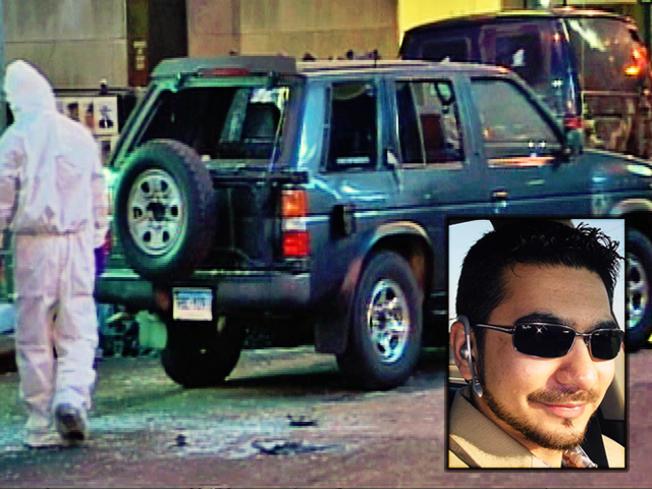
After reading what has already been written in this article you should be able to pick out quite a few mistakes in the New York Police Department (NYPD) handling of the 2010 car bomb incident in Times Square in the City of New York.
The vehicle that contained the explosives was a dark blue 1993 Nissan Pathfinder sport utility vehicle with dark tinted windows, it had been parked on a busy tourist-crowded street. People in the area noticed smoke drifting from vents near the back seat of the unoccupied vehicle, which was parked with its engine running and its hazard lights on. They also heard firecrackers going off inside.
A police officer approached the car and observed the smoke, canisters inside, and the smell of gunpowder. The vehicle was set ablaze, but did not detonate. Upon arrival, the bomb disposal team used a remote-controlled robotic device to break out a window of the vehicle, and explore its contents. The device’s ignition source malfunctioned and failed to detonate the main explosives. Had it detonated NYPD officials said the bomb would have cut the car in half, and “would have caused casualties, a significant fireball and would have sprayed shrapnel, and killed or wounded many people.
OK, the U.S. had been engaged in the war on terror for 9 years, so do the NYPD and other agencies not know how to deal properly with a car bomb incident? It amazed me when I saw the incident on the TV; they showed the bomb squad defusing the device with crowds nearby watching. Basic rule, you and your cordon positions must be out of line of site of the device, if you can see the device you can be hit by shrapnel etc. If the device had detonated there would have been many un-necessary casualties from the stupid cordon positions alone. The car bomb was described as a crude device, so was it not taken seriously? My first thought if I came across a crude and amateur explosive device would be, where is the real one, and that the crude device was nothing but bait to draw security forces into a trap. I strongly doubt the area and cordon positions were checked for secondary devices. In the TV coverage you could see that roads at either end of the road where the device was located were still open and cops were milling and sitting around relaxing, a suicide bomber could have driven right through the cordon and blown up the bomb squad, you can’t protect others if you can protect yourself! The NYPD’s handling of this incident can be classed as very negligent and how you should not deal with an IED incident!
If you are in an urban area and there is a car bomb incident you should initially find cover, get into a building and away from windows. If a device goes off the shock wave can break windows for few blocks around it. You don’t want to be on an open city street will glass falling on you from 50 stories up. When safe to evacuate the area use back allies and non-obvious routes and do not hang around to watch how things develop. This is because of the threat from secondary devices and because the first device may only be there to draw in crowds of onlookers or channel people into the main device.


